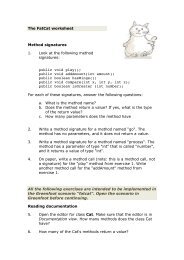SCIENCE TEST
SCIENCE TEST
SCIENCE TEST
You also want an ePaper? Increase the reach of your titles
YUMPU automatically turns print PDFs into web optimized ePapers that Google loves.
Earthquakes produce seismic waves that can travel<br />
long distances through Earth. Two types of seismic waves<br />
are p-waves and s-waves. P-waves typically travel<br />
6−13 km/sec and s-waves typically travel 3.5−7.5 km/sec.<br />
Figure 1 shows how p-waves and s-waves move and are<br />
ACT-64E-PRACTICE<br />
both p-waves and<br />
s-waves received<br />
at seismographs<br />
103°<br />
shadow zone:<br />
neither p-waves nor<br />
s-waves received<br />
at seismographs<br />
earthquake<br />
focus<br />
Note: The figure is not to scale.<br />
0°<br />
solid<br />
inner<br />
core<br />
mantle<br />
142° 142°<br />
only p-waves received<br />
at seismographs<br />
Figure 1<br />
42<br />
Earth’s interior. Figure 2 shows a seismograph (an instrument<br />
that detects seismic waves) recording of p-waves and<br />
s-waves from an earthquake. Figure 3 shows, in general,<br />
how long it takes p-waves and s-waves to travel given distances<br />
along the surface from an earthquake focus (point of<br />
origin of seismic waves).<br />
liquid outer core<br />
crust<br />
Key<br />
both p-waves and<br />
s-waves received<br />
at seismographs<br />
103°<br />
p-waves<br />
s-waves<br />
shadow zone:<br />
neither p-waves nor<br />
s-waves received<br />
at seismographs<br />
4 4<br />
ch seismograph from<br />
uake focus (min)<br />
22<br />
20<br />
18<br />
16<br />
14<br />
12<br />
10<br />
time<br />
earthquake<br />
starts at the<br />
focus<br />
s-waves<br />
p-waves<br />
first p-waves<br />
arrive at<br />
seismograph<br />
Figure 2<br />
first s-waves<br />
arrive at<br />
seismograph<br />
GO ON TO THE NEXT PAGE.<br />
1<br />
minute<br />
2. According to Figure 1, when p-waves encounter the<br />
boundary between the mantle and the core, the<br />
p-waves most likely:<br />
F. stop and do not continue into the core.<br />
G. enter the core and are refracted.<br />
H. change to s-waves.<br />
J. change to a third type of seismic wave.<br />
3. Based on Figure 3, for a given seismograph, the time<br />
elapsed between the arrival of the first p-waves and the<br />
arrival of the first s-waves from an earthquake focus



